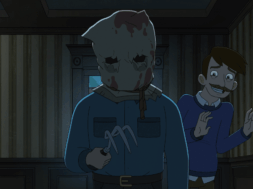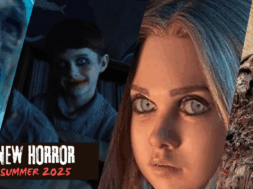I am very proud to welcome you to our first installment of Unveiling The Mind. This new bi-monthly column will focus on critiquing works that involve representations of mental illness. As someone who lives with mental illness, art has been a profound means for me to better understand myself and find inner peace.
Through Unveiling The Mind, it’s my hope to highlight the incredible power art has to enlighten and even heal. One thing I want to make clear for this article and for all the articles that follow, is that each reading of these works is based on my own point of view. I understand and respect that everyone’s journey is different. I want to provide the best care I can to the various subjects to come, and want to be clear that these analyses are of my own opinion, research, and (potential) experience.
So without further ado, let’s dive into our first title.
As of last month, Martin Scorsese’s Shutter Island turned 10 years old. The film follows Teddy Daniels (Leonard DiCaprio), a court-martial who is asked to investigate the disappearance of a woman named Rachel from Ashecliffe Hospital (a mental institution for the criminally insane). But Teddy isn’t only at Ashecliffe to look for Rachel. Early on in the film, the viewer learns that Teddy’s wife (played by Michelle Williams) was killed in a fire by an Andrew Laeddis (who may be at Ashecliffe). As Teddy spends more time at the institution with his partner Chuck Aule (Mark Ruffalo), he comes to discover that there may be more to Ashecliffe than meets the eye. Upon uncovering a government conspiracy that may involve mind control, he attempts to take down Ashecliffe.
But not all is what it seems.
At the end of the film, we come to find out that Teddy is no longer a court-martial, but has been a patient of the institution for two years. He is actually Andrew Laeddis. Overtime, given Andrew’s drinking and absence among the family, his wife became manic depressive, insane, and suicidal, one day deciding to drown their children. It’s also revealed that the fire incident was started by her in an attempt to purposely burn down their apartment building. When Andrew found out about her drowning the children, he broke down and killed her. In order to cope with these events, he created a delusion where he is a hero taking down an evil conspiracy. On an additional note, the light flashes and migraines Andrew has been experiencing are actually withdrawal symptoms from him being off his meds.
The events the viewer has witnessed throughout the film are all part of an illusion set up by Ashecliffe, acting as a means of grandiose roleplay. The plan was set up by Ashecliffe’s director, Dr. John Cawley (Ben Kingsley) and Dr. Lester Sheehan (who we come to find out is the real identity of Andrew’s partner). Their hope was that, through the roleplay, Andrew would finally be able to accept reality.
For the sake of clarity moving forward, I will be referring to DiCaprio’s character as Andrew.
The way in which Shutter Island leads the viewer through its narrative allows for a fascinating dive into psychological mystery. From early on, Andrew shows signs of being an unreliable narrator. Upon re-watching the film, it’s fascinating to see how the dream sequences hint at the truth of his past, all while never revealing the full context. The viewer comes to understand how the little girl that appears in his dreams (his daughter) represents the guilt he has for not being able to save his family. From his surreal dreams, to seeing visions of his dead wife, Andrew’s mind serves to confuse the viewer.
Andrew is a victim of PTSD and displays symptoms of Delusional Disorder. His warped perception of reality stems from his inability to accept his actions; his mind is striving to avoid the horror of what has happened and what he has done. The roleplay plan is intriguing in how it strives to emulate aspects of Andrew’s past, as a means for him to re-experience them in a sense. One example being how Rachel drowned her children, just like how Andrew’s wife drowned their children. Roleplay and exposure therapy can be useful in helping folks with certain disorders, allowing them to process their trauma. But obviously, extreme forms of roleplay may not be the best path to help folks who suffer from PTSD.
On a narrative and thematic level, however, it’s interesting to see how the plan feels aligned with certain beliefs of mental illness treatment brought up in the film. This can be best understood through the lens of Dr. Cawley and in how he treats patients. Early on he makes it clear to Andrew how he is against the “old school” way of treatment – locking people away. He states how today, the last resort (such as pills and isolation) is becoming the first response. Cawley’s belief is that if you treat a person with respect, try to understand them, then maybe you can reach them. With this in mind, we can recognize how his and Sheehan’s plan is structured to help Andrew process his trauma. How it relies on everyone working together to help someone struggling.
Besides Andrew, there are a few other patients that get limited screen time. Of these characters, there is one that makes for a particularly interesting component to the film – Mrs. Kearns.
When speaking to Mrs. Kearns, Andrew makes a comment about how “normal” she seems; compared to another patient he has spoken to, Kearns is gentler in presence. She tells him that she is locked away for killing her husband – though, she was justified in killing him, given that he continuously beat and cheated on her. While she’s an interesting character for Andrew to come across, she also represents an important point-of-view for the viewer. Here is a character whose mentality is warped, but who is also able to take responsibility for their actions. She is a contrast to Andrew, the latter who cannot accept what he has done. The emphasis on Mrs. Kearns’ level of coherence is important to acknowledge. For many years we’ve had depictions in film where those with mental illness tend to be associated as violent; and yes, while Shutter Island does take place at an institution for the criminally insane, it helps to include a character who is self-aware and in control of their actions.
Speaking of an institution for the criminally insane, such a setting could potentially find itself displaying a plethora of tropes. But thankfully, the setting, and its characters, all work for the film. Andrew does come across a few eccentric characters (two that are aggressive). Unlike movies of the past, though, Shutter Island doesn’t give off a vibe of, “Oh look how crazy these people are!” When Andrew expresses notions like that, Cawley provides his counterpoint (regarding how these are patients in need of help).
Outside of character personalities, some imagery is meant to exude a creepy feeling. But these moments feel a little on the nose, almost as if they are purposely toying with tropes. In short, nothing about Shutter Island feels exploitative. The melodrama that is present never gets overly cheesy, and instead, elevates the emotional distress that Andrew is going through.
I believe Shutter Island is a positive take on mental illness representation. DiCaprio’s portrayal of Andrew stands as a heartbreaking tale of recovery and acceptance. And though the film includes surreal dream elements, the portrayal and pain of Andrew’s PTSD feels sincere.
Shutter Island aims to encourage sympathy from the viewer; not to agree with what Andrew has done, but to understand where his logic is coming from. The film makes a unique effort to provide a tale about a group of people trying to save one person – to guide him through healing. There are moments where it feels Shutter Island may dip into some gray areas of representation, but then it reels itself back in (as if to play with the thriller and noir genres it takes inspiration from). In the end, Shutter Island is an intriguing story about how important it is that we acknowledge mental illness and make an effort to help those who are struggling.
Thank you all for taking the time to read our first installment of Unveiling The Mind. I look forward to bringing you new articles every other month. By exploring the various representations of mental illness (both good and bad), I hope these articles are able to help folks out there who are looking for greater understanding of mental illness (whether it is for themselves or a loved one).
I’ll see you in May with the next installment.











